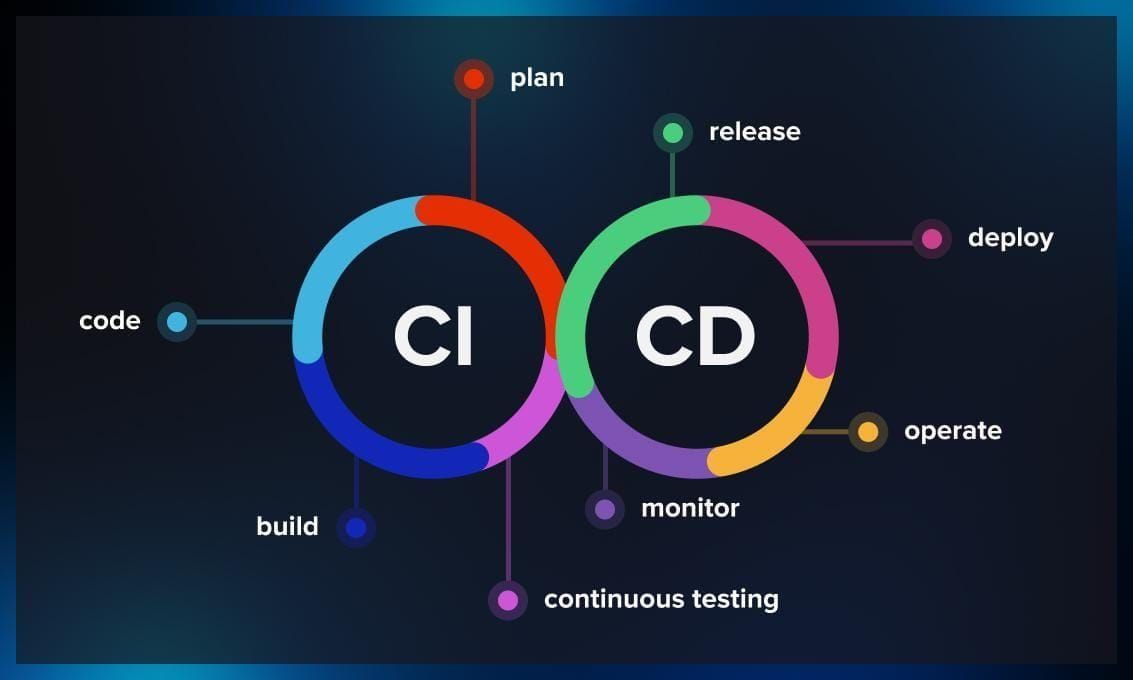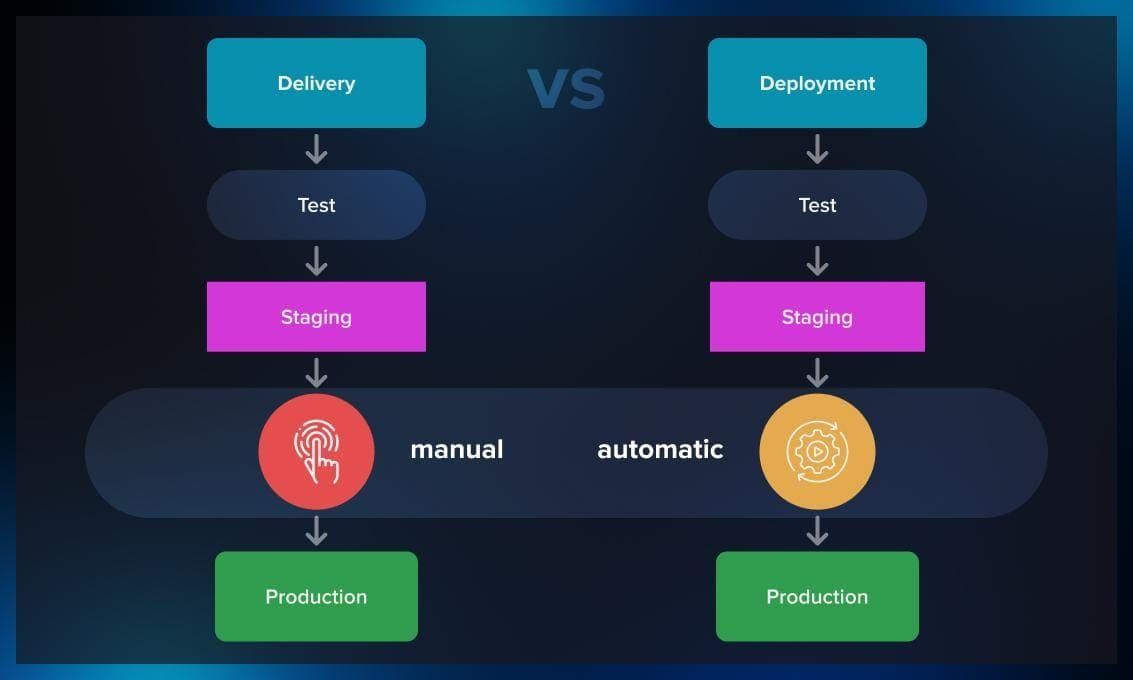Nix is a powerful, purely functional package manager that offers reliable and reproducible build and deployment processes, eliminating many of the challenges traditionally associated with software lifecycle management. In this article, we explore the integration of Nix with CI, CD, and CT pipelines and explain how it can streamline DevOps and MLOps processes.
What is a CI/CD pipeline?
CI/CD stands for continuous integration and continuous deployment (or continuous delivery). A CI/CD pipeline is a set of automated processes that facilitate the building, testing, and deployment of software. The primary goal of a continuous integration and continuous deployment is to streamline the development and release process, making it more efficient, reliable, and consistent.
CI/CD pipelines greatly contribute to reducing the time it takes to bring new features and improvements to software while maintaining a high level of code quality and reliability.

The essential stages within the CI/CD pipeline include the following stages:
Continuous integration (CI)
Continuous integration, a key element of DevOps, is the software development practice of regularly merging code changes into a main repository. All changes are automatically built and run against tests. CI predominantly focuses on the software’s build or integration phase. Beyond the automation aspect, it also entails a cultural shift, emphasizing frequent integration. The main goals are to quickly find and fix bugs, improve software quality, and make the validation and delivery of software changes more efficient.
Continuous testing (CT)
Automated tests are part of CI, ensuring that new code doesn’t break existing functionality. Continuous testing encompasses various types of tests, including functional assessments, user experience evaluations, and checks for potential code vulnerabilities. It automates the testing process, thereby speeding up quality assurance and mitigating potential issues in a production environment.
Continuous delivery (CD)
The phase of continuous delivery introduces automation into the code release cycle. This entails the automated execution of tests and construction of software. Once the CI phase is completed, code is positioned into a staging environment and further to the production environment.
Continuous deployment (CD)
At the stage of continuous deployment, software is thoroughly scrutinized against various criteria. Then it is automatically introduced into the production environment. If any anomalies emerge, the system reverts to the previous iteration of deployment.
What is the difference between continuous deployment and continuous delivery?
Continuous deployment and continuous delivery are related concepts that focus on automating the deployment of code changes to production. These processes are slightly different in terms of automation, which we explain in point 6 below.
A typical CI/CD pipeline involves the following stages:
1. Code changes
Developers write and commit code changes to a web-based platform with version control features (such as GitHub).
2. Automated build
The CI/CD pipeline starts with an automated build process that compiles the code, packages dependencies, and generates deployable artifacts (e.g., binaries, containers).
3. Automated testing
Automated tests, including unit, integration, and possibly even performance tests, are executed to ensure that the code changes haven’t resulted in any bugs or defects.
4. Deployment to staging
In continuous delivery, the application is deployed to a staging environment that replicates the production environment. This helps identify issues that might not have been caught by automated tests before the updates are available to the public.
5. User acceptance testing (UAT)
In some cases, a manual and/or automated user acceptance testing phase is performed in the staging environment to ensure that the changes meet business requirements.
6. Deployment to production
In continuous deployment, once the changes pass all tests and checks, they are automatically deployed to the production environment. In continuous delivery, this step is manual and is triggered by the development team or stakeholders.

7. Monitoring and feedback
After deployment, the application is continuously monitored in the production environment. Any issues that arise are addressed promptly, and feedback is used to further improve the process.
What is the relationship between CI, DevOps, and MLOps?
Continuous integration is a foundational practice within the DevOps methodology.
DevOps is a broad area that encompasses various practices, principles, and tools aimed at fostering collaboration between development (Dev) and operations (Ops) teams. The core goal of DevOps is to break down silos between these teams and create a more streamlined and automated software development and deployment process. DevOps emphasizes automation, continuous improvement, and the alignment of development and operations goals.
MLOps (Machine Learning Operations) is a set of practices, methodologies, and tools that combine ML and DevOps to facilitate the deployment, management, and continuous improvement of machine learning models in production environments. MLOps aims to bridge the gap between data science, machine learning development, and operations teams, ensuring that ML models are developed, deployed, and maintained efficiently.
How to automate MLOps through CI/CD/CT?
The automation of MLOps involves the following stages:
1. Data preparation: collecting and preprocessing the data.
2. Model development: training, validating, and improving ML models.
3. Model testing: assessing the models across various datasets and in different scenarios.
4. Model deployment: rolling out the models in a production-like environment.
5. Model monitoring: observing ML models in production and updating them as necessary.
Now let’s look at the CI/CD/CT tools that enable the automation of these stages.
Continuous integration
Version control: with a version control system like Git, you can monitor changes to your code and data.
Automated testing: PyTest, pytest-cov, and Codecov enable writing and executing automated tests for your code and models.
Static code analysis: PyLint, Flake8, and Bandit ensure that your code aligns with stipulated style, syntax, and security norms.
Continuous integration server: CI servers like Jenkins, CircleCI, or Travis CI automate the compilation, testing, and validation phases.
Continuous delivery
Infrastructure as code: Terraform, CloudFormation, or Ansible are great tools for managing your infrastructure as code.
Dockerization: With Docker, you can create transferable, reproducible, and independent environments for your models.
Continuous deployment server: CD servers such as Kubernetes, Amazon ECS, or Google Cloud Run automate the deployment process.
Check out this article for more information on CI/CD tools.
Continuous testing
Unit testing: unittest, PyTest, or nose to design and run unit tests for your ML models.
Integration testing: use Robot Framework, Behave, or PyAutoGUI to verify the integration of your models with other systems.
Load testing: Apache JMeter, Gatling, or Locust can evaluate model scalability and performance.
A/B testing: use TensorFlow Serving, KubeFlow, or SageMaker to deploy various model iterations and assess them against diverse user groups or scenarios.
Check out this article for more information on CT tools.
Watch this video to learn how to enable continuous delivery of machine learning to production using CI frameworks:
How is Nix used in DevOps and MLOps?
One of the most complicated issues is the task of isolating users’ errors in separate virtual environments. This enables developers to analyze each case individually and address the problem.
Nix in DevOps
In DevOps, Nix assists in the following tasks:
- Dependency management: In DevOps, managing dependencies across different projects, stages, and environments can be challenging. Nix provides a way to specify dependencies in a declarative manner, ensuring that each project has its isolated and consistent environment.
- Reproducible builds: DevOps practices emphasize the importance of reproducibility in software development. With Nix, you can precisely define the software components needed for your builds, ensuring that builds are reproducible over time and across different systems.
- Continuous integration and deployment: Nix can be used for development of CI/CD pipeline components to ensure that software is built and deployed in consistent environments. This reduces the chances of unexpected issues due to discrepancies in dependencies.
- Infrastructure management: Nix’s declarative configuration approach extends to system setups. In DevOps, this means defining server configurations, services, and software deployments in a consistent and reproducible way.
- Environment testing: Nix can be used to create isolated testing environments that closely mimic production setups. This helps in identifying and resolving issues early in the development process.
Nix in MLOps
In MLOps, NIx facilitates the developer’s work in the following areas:
- Reproducible experiments: In machine learning, it’s crucial to reproduce experiments and model training reliably. Nix allows you to define the exact environment and dependencies required for training a specific model, ensuring consistent results across different runs.
- Model deployment: When deploying machine learning models, Nix can be used to package both the model and its required dependencies into a container. This ensures that the deployment environment is consistent with the development environment, reducing deployment-related issues.
- Managing model dependencies: Machine learning projects often involve various dependencies, including libraries, frameworks, and data preprocessing tools. Nix simplifies the management of these dependencies by isolating them in a controlled environment.
- Environment consistency: In MLOps, maintaining consistent environments between development, testing, and production is one of the prerequisites. Nix helps in creating reproducible environments for model training, testing, and deployment.
- Versioning and collaboration: Collaborating on machine learning projects can be complex due to different environments and dependencies. Nix facilitates versioning of environments, making it easier to collaborate on code and models.
Nix pros and cons
Now that we’ve looked at the solutions Nix offers, let’s sum up its benefits and limitations that developers should be aware of.
Nix advantages for developers
Nix benefits include:
- Dependency management: You can explicitly specify all software prerequisites, ensuring that applications are built and run in a consistent environment regardless of where Nix is used. This eliminates the “it works on my machine” problem by ensuring that software runs the same across various environments.
- Reproducibility: Reproducible builds are easy and straightforward.
- Consistent builds: Nix allows you to match your CI’s build method by installing Nix locally and executing the build commands.
- Vast software repository: With the “nixpkgs” repository, there are more than 80,000 packages available. So you have high chances of finding your build and test tools there.
- Integration with CI systems: Nix easily integrates with several major CI systems.
Nix disadvantages
The drawbacks of Nix are far fewer than its advantages. We would mention:
- Learning curve: You have to go through a learning phase before mastering Nix.
- Cache management: While
nix-shellefficiently retrieves the software you request, it doesn’t automatically clean up afterward. Although this means no re-downloading for repeated use, it also means that the cache grows over time. So regular maintenance, such as usingnix-collect-garbage, becomes essential.
DevOps monitoring tools
Traditional development tools like code repositories, IDEs, debugging programs, and defect trackers need advanced monitoring solutions, ensuring continuity in integration and deployment.
A unified dashboard provides comprehensive visualization of metrics reported by services and infrastructure. This allows us to define appropriate resource allocation, tagging, and in-depth analysis in complex distributed environments.
Monitoring application performance is paramount. Beyond tracking key system metrics like CPU and RAM, you should check performance indicators such as page load times or delays from auxiliary services. For this purpose, you can use tools like SignalFx and NewRelic, which provide real-time analytics.
A notification and incident management system is essential for overseeing log management and fault reporting. This tool should deliver crucial alerts promptly and be able to consolidate and filter through multiple notifications, especially when one error or malfunction produces multiple alerts.
Conclusion
Nix is a functional package manager and build system designed to provide reproducibility, declarative configuration, and efficient creation and management of such software environments. It can be an effective tool in the management of software lifecycle.
Nix is particularly effective in DevOps and MLOps because of its ability to create isolated and reproducible software environments, making it easier to manage dependencies and configurations across different projects and systems.
Integrating Nix with CI, CD, and CT pipelines not only simplifies the complexities of DevOps and MLOps but also sets the stage for a more streamlined and efficient development lifecycle. That’s why Nix could be the game-changer many organizations and developers are searching for to enhance their operational workflows.





.jpg)

.jpg)
